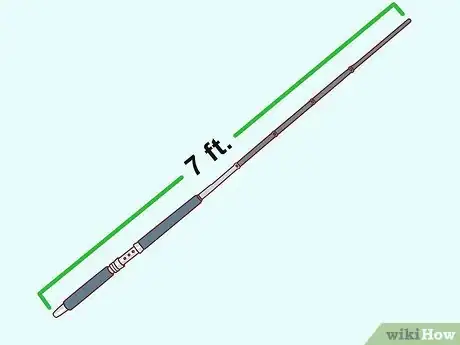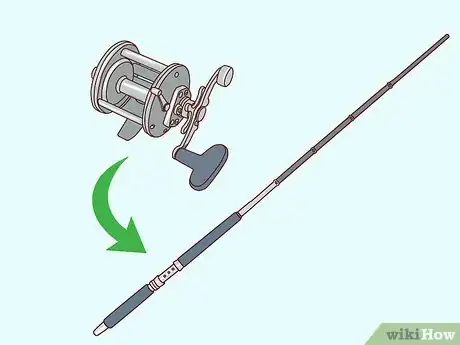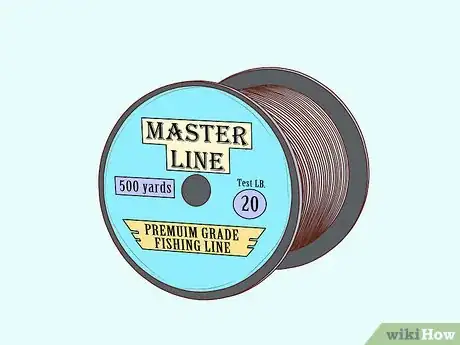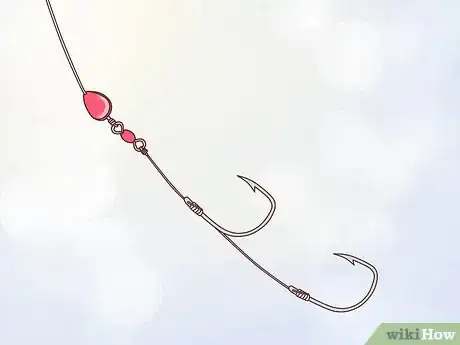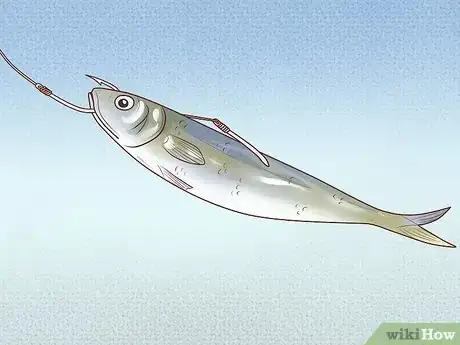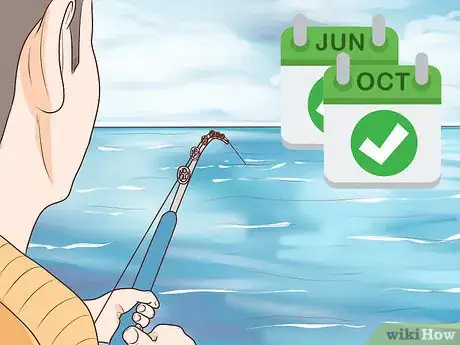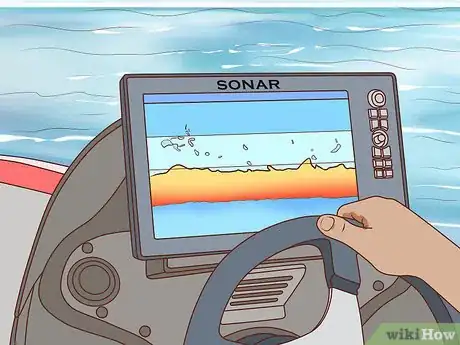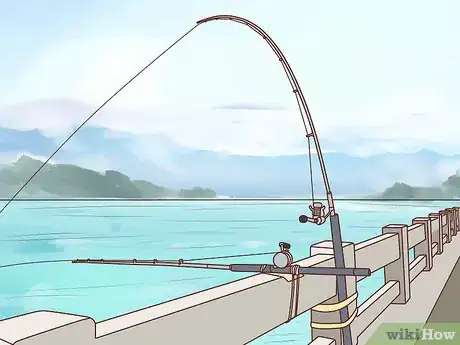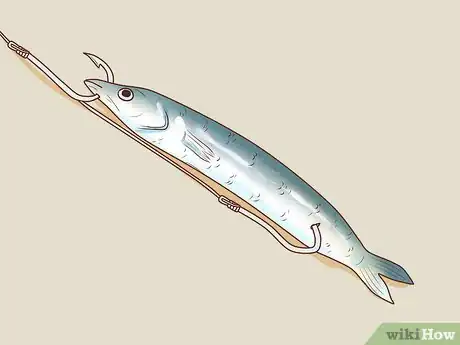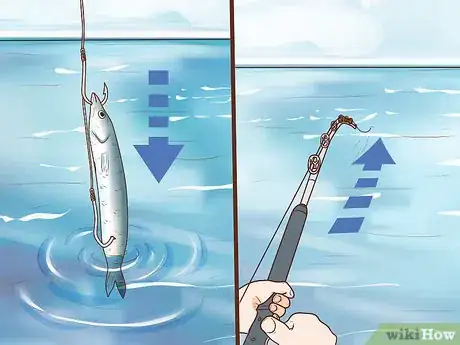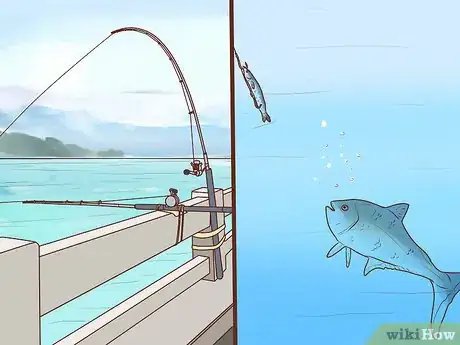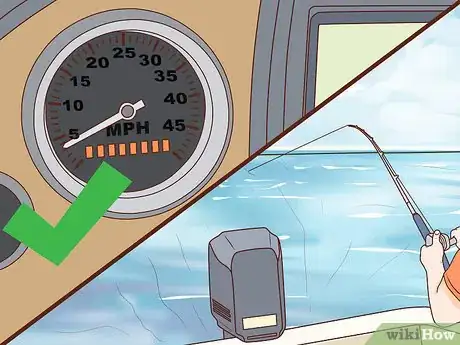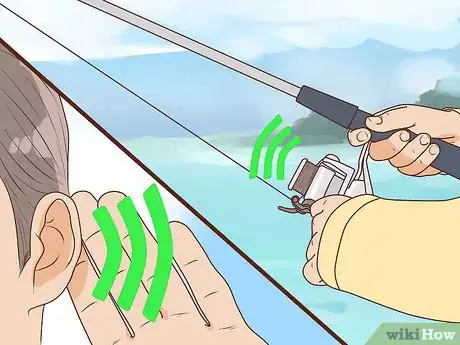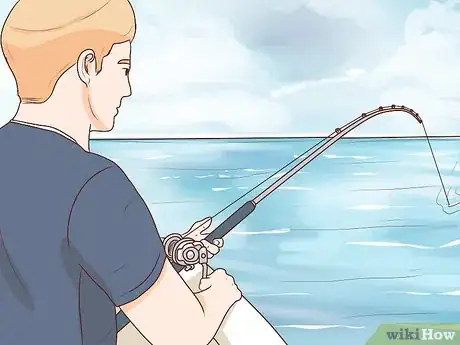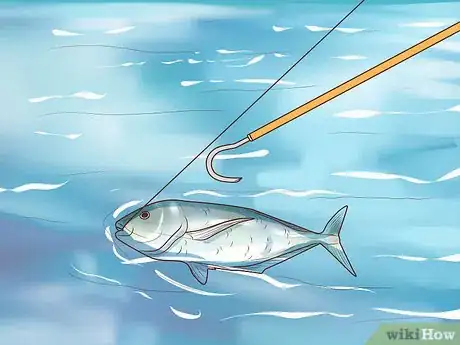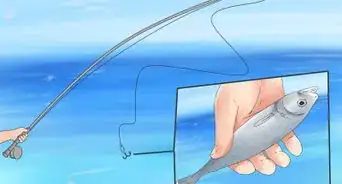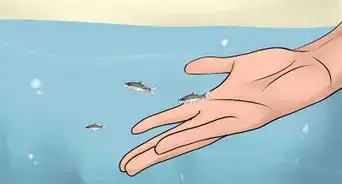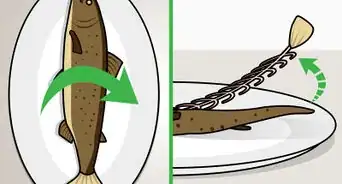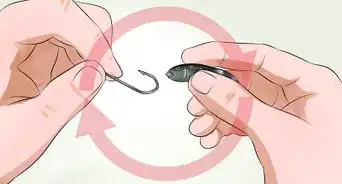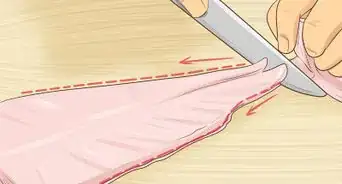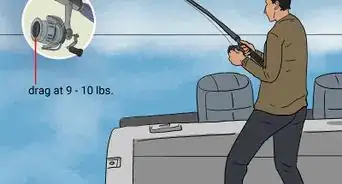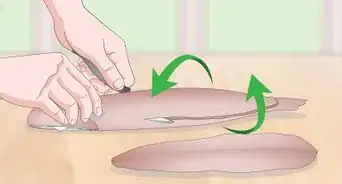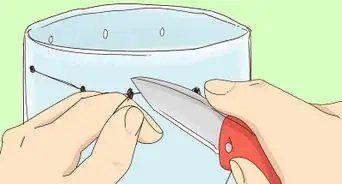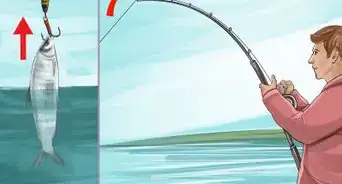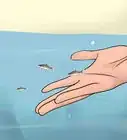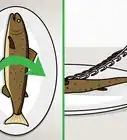This article was co-authored by wikiHow staff writer, Hunter Rising. Hunter Rising is a wikiHow Staff Writer based in Los Angeles. He has more than three years of experience writing for and working with wikiHow. Hunter holds a BFA in Entertainment Design from the University of Wisconsin - Stout and a Minor in English Writing.
There are 14 references cited in this article, which can be found at the bottom of the page.
This article has been viewed 56,211 times.
Learn more...
Kingfish, also known as king mackerel, are popular to catch and are primarily found in the Atlantic Ocean and Gulf of Mexico. Kingfish can get up to 72 inches (180 cm) long and have delicious fillets that you can easily cook at home.[1] Catching kingfish can be a challenge, but it can be easier with the right rod, line, and bait. Just be sure to check with your local laws to what the catch and size limits are for fishing in your area!
Steps
Assembling Your Rod
-
1Buy a medium or heavy rod that is 7 ft (2.1 m) long. Visit your local fishing or sporting goods store and look for a medium or heavy rod to use for the kingfish. Make sure the rod is at least 7 ft (2.1 m) long so you can capture heavier kingfish without worrying about it breaking.[2]
- Medium and heavy refer to how much the rod bends while you’re using it. Medium and heavy rods don’t bend as easily as light rods.
- You’ll have more chances to catch kingfish if you use multiple rods at a time.
-
2Attach a conventional reel to the rod. Look for conventional reels that are meant for saltwater at a sporting goods store. Make sure the reel can hold at least 250 yards (230 m) of line so the fish can pull it out without it breaking. Secure the reel to your rod and tighten the screws so it doesn’t come loose.[3]
- You can also use a spinning reel if you want, but it may be more likely to break since it has more moving parts.
Advertisement -
3Use a line with at least 20-pound test to catch your fish. The weight listed on a line, or the test, refers to how much pressure it can take before it breaks. Since the average size of kingfish is around 20–25 pounds (9.1–11.3 kg), use a line that supports a similar weight. Spool the line onto your reel so it’s ready to use when you’re on the water.[4]
- You can use a heavier line if you want, but it’s not necessary.
- It doesn’t matter whether you use mono or braided fishing line.
-
4Secure a 2-hook leader to the end of the line. A leader is a length of wire that attaches the hooks onto your bait and makes it more difficult for fish to cut the line. Look for a leader that’s nylon-braided and has a 45-pound test to support the weight of the fish. Cut the leader to a length of 3 feet (0.91 m) and tie 1 J-shaped hook to the end of it. Measure up the wire by 4 inches (10 cm) and tie another J-hook there. Tie the leader to your main fishing line.[5]
- Kingfish have very good eyesight and will see the glint of metallic wires underwater. Try to avoid leaders that are shiny or have a metallic finish.
-
5Get live bait fish for the best chances at catching kingfish. Kingfish prey on species like ribbonfish or sardines in the wild, so use them for your bait. Aim to have baitfish that are about 6 inches (15 cm) long so you have a better chance at catching larger kingfish. Bring a live-well filled with bait fish with you so you have replacements in case they’re eaten while on the line.[6]
- You can catch bait fish yourself or you can buy bait from a local tackle shop.
Tip: If you want to use lures rather than live bait, then you can try using artificial ribbonfish or spoons that are about 5–6 inches (13–15 cm) long.[7]
Finding a Fishing Spot
-
1Fish throughout the day between June and October. Kingfish are the most active when the waters start to warm up in the Gulf of Mexico, which usually starts in mid-June. Plan to fish during this time so you’re more likely to catch them. Kingfish bite throughout the day, so you can fish starting in the morning and end around sundown.[8]
-
2Talk to local tackle shops and anglers to see where people are fishing. Visit bait and fishing shops along the coast and ask them where popular fishing areas for kingfish are. See if they have heard about new spots from other anglers so you have a chance to try them out. If you know anyone in the area, ask them for tips on where others usually find the kingfish.[9]
- Check for large groupings of boats in certain areas since they may be fishing near a school of kingfish.
-
3Use a sonar device to look for underwater structures if you’re on a boat. Kingfish are usually found in open ocean water, so it can be hard to see where they are without using sonar. Once you’re on the water, turn on your sonar device and look at the layout of the ocean floor. Look for underwater shelves where the depth drops off or reef structures where baitfish live so you can find larger schools of kingfish.[10]
- You can buy sonar devices from outdoors stores.
- Sonar devices can also detect schools of fish so you can easily locate them nearby.
- Don’t go too far off the coast on a small boat since the waves could get large and damage it.
Tip: Kingfish and seabirds share the same prey. Look for sea birds flying over an area in the ocean since they may signal that kingfish are nearby.
-
4Set up an anchor rod if you’re fishing from a pier. Sometimes, kingfish will swim closer to shore so you can catch them from a pier. When you’re setting up, attach a light hooked anchor to the end of another heavy fishing rod. Cast the anchor about 50–100 yards (46–91 m) out into the water and slowly reel it back toward you until the hooks catch on something. Then, place your rod in a holder so it stays upright.[11]
- The anchor rod keeps the line on your main fishing rod from drifting away so it’s easier to manage and reel in.
- You may want to tie your anchor rod to the pier so it doesn’t accidentally get pulled into the water.
Catching the Kingfish
-
1Attach the hooks near the head and tail of your bait fish. Push the end of the first hook through the bait fish’s body directly behind its gills. Make sure the hook isn’t too close to the top or bottom since it could rip out otherwise. Then, run the wire leader along the bait fish’s back and poke the second hook 1–2 inches (2.5–5.1 cm) from the tail.[12]
- Make sure the fish is looking up the line toward the rod and reel. This will help the fish look like it’s naturally swimming once you put it in the water. If the bait is backward, kingfish may not strike it.
-
2Drop the bait into the water and let out 50 yards (46 m) of line. Once the bait is attached to the hooks, set the end of your line gently in the water. Pull the line out from your reel by hand and feed it into the water so it floats away from you. Stop feeding your line once the reel lets out 50–100 yards (46–91 m).[13]
- Don’t fish with your line right near you since kingfish might not approach it.
- If you’re fishing from a pier, make sure the line on your rod is attached to the line of your anchor with a downrigger clip so the line doesn’t float away.
-
3Wait for a fish to strike if you’re fishing from the pier. Once your bait is in the water, it will stay in place and swim around. Leave your rod alone and avoid moving it so the baitfish can naturally swim. Keep waiting until you see or hear the kingfish strike your line.[14]
-
4Troll the water at the slowest speed you can if you’re on a boat. Trolling is when you drive your boat slowly and drag fishing lines behind you. Set your motor to idle troll so your boat slowly moves through the water and pulls your line tight. Troll for about 100 yards (91 m) over an area before turning your boat around and trying again. You can either hold the rod or set it in a rack while you navigate the boat.[15]
- Be mindful of other anglers so you don’t accidentally tangle lines with them.
- If you do 3-4 passes of the same area without any bites, try finding a new fishing spot or check your bait to make sure it’s still on your line.
Tip: If you notice your bait fish skimming across the surface of the water, turn your engine off or lift it slightly out of the water to slow down.
-
5Listen for a fast clicking or humming sound coming from your reel. When a fish hits your line, it will rapidly pull out and make a clicking noise. Once you hear the line start to pull, grab the rod and hold the end of it points in the air. Don’t start reeling in yet since you could break the line if the fish is still pulling it out.[16]
- Kingfish can strike your bait at 40–50 miles per hour (64–80 km/h), so the line will be loud when a fish is on it. If you hear a single click, the line may have gone through seaweed or a smaller fish.
-
6Start reeling in when the line starts moving slower. Watch your line to see how fast the reel is spinning and once it goes quiet, begin reeling in the fish. Reel the fish in slowly so you don’t accidentally break your line or fight the fish too much. Alternate between pulling the tip of the rod toward you and reeling in short bursts. If the kingfish starts to pull your line again, stop reeling and let it swim.[17]
- Fishing for kingfish can take a while depending on its size and power. Keep reeling it in since the fish will eventually tire out and be easier to catch.
-
7Catch the kingfish with a gaff. A gaff is a large hook on the end of a pole used to get larger fish out of the water. Guide the fish close enough to you so you can easily get it out of the water and hook the gaff in the middle of the fish’s body. Pull the fish up so you can unhook it from your line.[18]
- If you don’t plan on keeping the kingfish you caught, then wear a fishing glove and grab the kingfish by the tail once you get it close.
Community Q&A
-
QuestionIf not live bait, what else can be used to catch the kingfish?
 Community AnswerLive bait is best, but if you can't get the live bait, use spoons and slow troll them.
Community AnswerLive bait is best, but if you can't get the live bait, use spoons and slow troll them.
Warnings
- Always check the catch limits and restrictions in your area before you start fishing.⧼thumbs_response⧽
- Kingfish have sharp teeth, so avoid putting your hands near their mouth after you catch them.⧼thumbs_response⧽
Things You’ll Need
- 7 ft (2.1 m) fishing rod
- Conventional reel
- 20 lb (9.1 kg) line
- J-hooks
- Wire leader
- Baitfish, such as sardines
- Sonar unit
- Fishing boat
- Gaff
References
- ↑ https://myfwc.com/wildlifehabitats/profiles/saltwater/mackerel/king-mackerel/
- ↑ https://youtu.be/6tvepvsIyn0?t=96
- ↑ https://greatdaysoutdoors.com/2018/06/trolling-for-king-mackerel/
- ↑ https://greatdaysoutdoors.com/2018/06/trolling-for-king-mackerel/
- ↑ https://www.sportfishingmag.com/12-steps-to-catching-trophy-king-mackerel#page-5
- ↑ http://www.spottedtail.com/free-florida-fishing-information-slow-trolling-for-king-mackerel/
- ↑ https://youtu.be/lhJXS18EKQg?t=73
- ↑ https://greatdaysoutdoors.com/2018/06/trolling-for-king-mackerel/
- ↑ https://www.sportfishingmag.com/12-steps-to-catching-trophy-king-mackerel#page-4
- ↑ http://www.spottedtail.com/free-florida-fishing-information-slow-trolling-for-king-mackerel/
- ↑ https://www.theonlinefisherman.com/how-to-fish/how-to-catch-kingfish-part-i-trolley-rig
- ↑ https://youtu.be/6tvepvsIyn0?t=58
- ↑ https://youtu.be/6tvepvsIyn0?t=130
- ↑ https://www.theonlinefisherman.com/how-to-fish/how-to-catch-kingfish-part-i-trolley-rig
- ↑ https://www.sportfishingmag.com/12-steps-to-catching-trophy-king-mackerel#page-7
- ↑ https://youtu.be/6tvepvsIyn0?t=262
- ↑ https://youtu.be/6tvepvsIyn0?t=277
- ↑ https://www.sportfishingmag.com/12-steps-to-catching-trophy-king-mackerel#page-12
